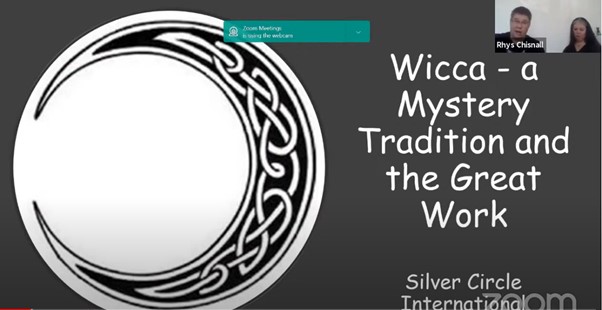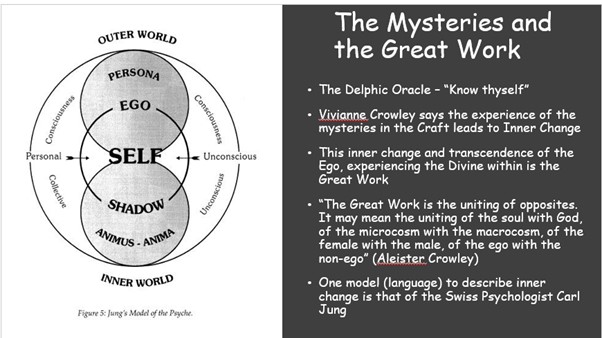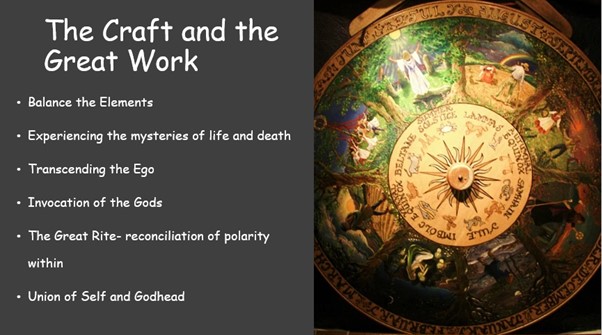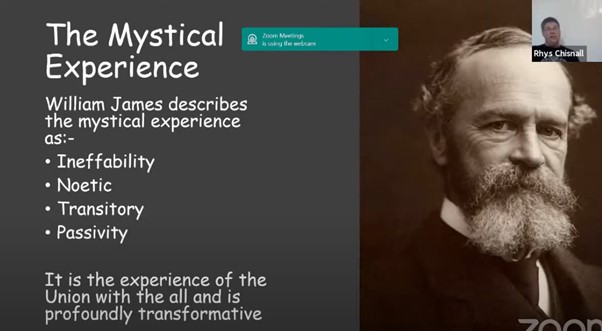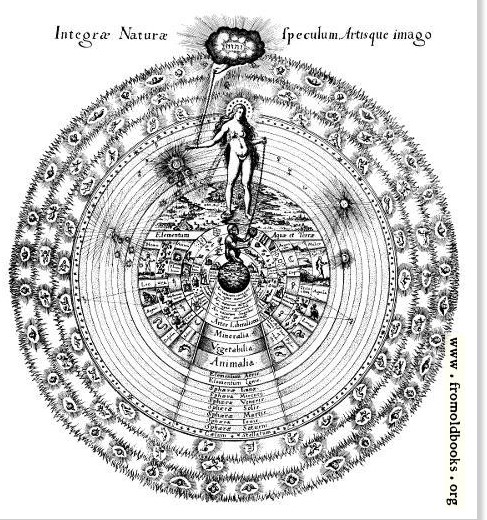On September 5, 2021 we held our Silver Circle Autumn online gathering. Rhys Chisnall was our first guest speaker:
There are many ways in which people think about Initiatory Wicca. I was taught that it is as a Mystery and Magical Tradition, but what does this mean?
According to the historian of religion Karen Armstrong, the word mystery come from the Greek word ‘mystírio,’ (μυστήριο) which means ‘to close or to shut the mouth’. This suggest to me that the word mystery means something that can’t be adequately described in everyday language. “Of which we cannot speak we should remain silent”, to paraphrase the philosopher Wittgenstein. However, this still leaves a certain degree of ambiguity, as the word mystery can mean one of three things and this can cause some confusion.
Firstly, it could mean a tradition that keeps things secret. To some extent this is correct, as initiatory Wicca does keep some things secret, although I think private would be a better word to use. There are some techniques that might be potentially dangerous or misused if they were common knowledge, but also there are some rituals that might be spoilt if they were known by a participant beforehand. This is especially true for initiation rituals. A wonderful example was given by Prof. Joseph Campbell, the late great American expert of mythology. He described a ritual where the initiate is taken through a set of ordeals before they enter into the holy of holies. Here the new initiate is told by the elders that they will encounter their God face to face. They are taken into the inner sanctum to the altar, a veil is removed and they find themselves peering into a mirror – they see themselves. Now, if the climax of the rite were known before, the initiate would have not had the transformative experience that the rite was designed to produce. The ritual would have been spoiled – and it is the same in the Craft.
That being said, while there is a strong element of privacy to our rituals, this is not what I mean by mystery tradition.
A second meaning for the word mystery refers to a mystery to be solved. This is something that scientists and detectives are very good at. The scientist or detective comes across the mystery and, using various methods, solves it. The problem is encountered and the solution is derived. Thus, the mysteries of the universe, or the case of the Hound of the Baskervilles, is solved. This is not what I mean by the word mystery in mystery tradition when talking about the Craft.
Rather, it was best summed up by the French Christian existentialist philosopher Gabriel Marcel. He said that mysteries are experiences in which we participate. These experiences, as Armstrong suggested, can’t be explained adequately in everyday language. This is why we need the language of poetry, music, ritual and mythology. These mysteries can be the experience of Nature, of the human life and the Divine. They can be the experience we have when nature makes us feel very small. It can be when we witness a sunrise, a flower open, or experience nature ‘red in tooth and claw.’ It can be the experience of motherhood, giving birth and death. It can be the experience of the encounter with the Great Goddess of Life and the Horned God of Death and Resurrection. These experiences can by numinous in quality, and can be thought of as the ‘lesser mysteries’.
Numinous experiences, a term coined first by theologian Rudolph Otto, are of the ‘other’, and leave us with a profound sense of awe. We feel that something profoundly important has happened to us. The psychologist Carl Jung reckoned that the encounter with the archetypes of the collective unconscious is a numinous one. Certainly, the archetypal experiences of birth, growing up, sex and sexuality, parenthood, sacrifice, old age and death, have can have this numinous quality, and offer a visceral connection to life, onto which we cannot help but place out own meaning. To my mind, this is part of what the myth of the Wheel of the Year does, it helps us to celebrate and make meaning from life’s inevitabilities. It brings us into contact with the mysteries of life. The Craft then celebrates the mysteries of life and death – Goddess and Horned God.
One of the great maxims of the Craft and the Occult in general, was said to have been inscribed on the arch leading to the Delphi Oracles. It said, ‘Know thyself.’ This was also a tenant of Socrates, when Plato has him say, “the unexamined life is not worth living.” This is where the mysteries relate to the Great Work.
The Great Work is where we explore the mystery of ourselves and relate it directly to the Divine. This is not an intellectual exercise, but direct experience, it is a mystical experience- which can be termed the ‘Greater Mysteries.’
In her brilliant book Wicca the Old Religion in the new Millennium, Viviane Crowley explains that experience of the mysteries leads to inner change. This inner change is where the initiate begins the work of transcending the ego (that which we think we are) and to experience and identify with the entire self. Psychologist Carl Jung, who was heavily influenced by the esoteric traditions, argued that there is much more to us than the ego. Once the person has begun to identify with the self (a life-long process he called Individuation) they can then experience and identify the self with the Divine. In Qabbalistic terms, the initiate first reaches the sephiroth of Tiphareth, the centre of the self, or the ‘Higher self’ before relating that self to Kether, the Divine source. Metaphorically the inner sun of the self – unites with the outer sun of the Divine.
Occultist Aleister Crowley agrees when he says “the Great Work is the uniting of opposites. It means uniting the soul with God, of the microcosm with the macrocosm, of the female with the male, of the ego with the non-ego.” The model and language of Carl Jung becomes very useful to describe this kind of inner change. The Initiate has to transcend their ego and expand their consciousness. It means being able to reconcile the polarity within oneself. This means the reconciliation of the ego and the shadow, of the persona and the anima/animus. This is the sacred marriage of Goddess and God that occurs within the Witch. These aspects of ourselves, the dark side and the light, the masculine and the feminine, Goddess and God have to be explored and integrated into our sense of self, so that they constellate around the pivotal point of self. Ego is then transcended or dissolved as the self is experienced as divine. As Joseph Campbell said, “we are all God in our deepest identity”. This is ultimate reconciliation of polarity. The reconciliation of self and the Divine is experienced first of all in invocation of the Gods and then in mystical experience – the Greater Mystery.
Thankfully, the Craft and the Western Mystery Tradition in general provides us with a road map for the Great Work. Unlike the classical mystic who goes from zero to hero, the occultist and Witch takes the more crooked path of the mysteries.
They begin by working on the lower self, connecting us to the world about us and working on our bodies and mind. This is where we begin work with the classical elements. These not only connect us with the world about us, but they also relate to aspects of our being, connecting us to body, emotions, thought and desire/will. The elements are states of being, but also metaphors for ourselves and our faculties.
Once initiated we participate in the wheel of the season, the great metaphor for life. It brings us into connection with the mysteries of life and death through the myth of the Great Mother and Horned God. We start to experience nature and the human as Divine. This is where the initiate begins to start the process of inner change, of transcending the ego, as they encounter the mysteries. However, all this takes work, hence the term, the Great Work. Often the ego rebels or can become inflated.
The underworld initiation, is where the ego needs to experience and understand its own demise. The Initiate learns to transcend ego and expand consciousness further through the process of being invoked upon. Here the witch or occultist expands their consciousness and begins to experience the identification with the divine. To my mind this is very different to trance possessions in Voodoo. Here the person goes into a trance and takes on the personality of one of the Lwa, and acts accordingly. The Gods of the Craft are a different category than Lwa who are spirits based upon Catholic saints.
Instead in invocation, the witch raises their consciousness to a divinity that is already there – always there, and then brings through the power of that divinity for the coven. To quote Herne the Hunter in the TV series Robin of Sherwood, “we can all of us be Gods”. This is the mystery that nature, humanity and the Divine are one. It requires the transcendence of ego and the expansion to consciousness to at least a part of the Divine.
Next comes the Great Rite. Its inner form is the reconciliation of the polarity within the initiate, the reconciliation of male and female, Goddess and God, light and dark, self with the divine, the inner and the outer sun. This leads potentially to mystical experience.
The philosopher and pioneer psychologist William James described the mystical experience in his book, The Varieties of Religious Experience. It is the experience of ‘at oneness’, the union with the divine, where all contradictions disappear and we are at one with what Paul Tillich called the ‘ground of being’. It is the greater mystery, a profoundly transformative experience – after which life is never the same again. James says that the mystical experience is ineffable in character. It could not be described in everyday language. When taking about the mysteries and the mystical experience, we often have to resort to talking in metaphor. That is why this article is extremely metaphor laden, with its ‘joining of the inner and outer sun’ etc. James said mystical experiences are noetic, meaning that we learn some thing from them. This is not the ‘knowledge that’ or ‘knowledge how’ of the philosopher Gilbert Ryle, but rather the ‘knowledge of’ – what some people call gnosis. These mystical states are transitory, while they seem to last for an eternity to the experiencer, they actually last for seconds. James also said that these experiences are something that happens to you and they can’t be brought on by a direction of will.
All of this is a process. The Great Work does not happen overnight. Indeed, it is a life-long process, and it may well take much longer than that. The Mystical Experience is not the end part of the Great Work and your Craft career. Rather it is the midpoint. From there, as in Joseph Campbell’s monomyth, we have to be able to accommodate the transformative experience into our everyday lives – we must learn to be masters or mistresses of two worlds. We need to make sense of what we have learned and to help bring others to these kinds of profound and transformative experiences. The mysteries were always a call to action.
In my experience the Craft is a mystery and magical tradition. It is part of what is known as the Western Mystery Tradition. As Viviane Crowley says it deals with metaphorical and metaphysical truth, not scientific truth. The mysteries are expressed through the metaphor of ritual and myth, and metaphysically it sees all as one, and one as all. Everything is a unity and all is connected, in that sense like it’s parent Hermeticism, it is deeply mystical. This means we should treat the Craft as an esoteric mystery tradition rather than an exoteric religion. I agree with Jung when he says that religion is the greatest barrier to a religious experience.
In the Craft, as indeed within the Western Mysteries, there is no part that is not of the Gods. When we connect with the Divine within, we connect with the Divine without, as in the Hermetic maxim of “as above, so below and so within, so without”. Rather than seeking to separate the world into different ever decreasing categories, we should be looking for commonality, all is part of one. We should be thinking as Dion Fortune did, that ‘all gods are one god and all goddesses are one goddess, but there is one initiator.’ In the mystery traditions we should be making connections, not separating, looking and identifying with the whole, and not just the separate parts.
References:
Integrae Naturae: https://www.fromoldbooks.org/Various-Occult/pages/Fabricius-Fludd-Natura-Mirror/
Armstrong, K., (2011) The Case for God: What Religion Really means, Vintage,
Crowley, A., (2004), Magick Without Tears, New Falcon Publications,
Crowley, V., (2016), Wicca a Comprehensive Guide to the Old Religion in the Modern World, Elements,
Fortune, D., (2003), The Sea Priestess, Weiser,
James, W., (2004), Varieties of Religious Experience, Digireads
Marcel, G., as cited in Armstrong, K., (2011) The Case for God: What Religion Really means, Vintage.
Silver Circle Autumn online gathering
The following speakers joined us for the Silver Circle Autumn Online Gathering Rhys Chisnall, Melissa Harrington and Thorn Nightwind. Rhys spoke about ‘Wicca, a mystery tradition – The Great Work’. Wicca can be many things, but one way of experiencing it is as a mystery tradition. But what does this mean? In this talk Rhys answered this question and also considered what is meant by the Great Work and how this can be the process that leads to mystical experience…

